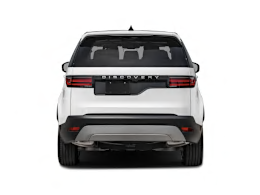Land Rovers have traditionally been square-edged, robust off-roaders, but it's clear from first glance that the latest Discovery is far different than its predecessors. No longer a truck-like implement, the Disco has been transformed into a luxurious, contemporary three-row SUV that's still able to handle a few off-road excursions.
The robust six-cylinder powertrain delivers on-demand acceleration, the air suspension provides a firm but steady ride, and the cabin is as quiet as Wimbledon's Centre Court the moment before a serve. The cabin is luxurious and tastefully furnished.
Yet the Discovery suffers from a lack of agility as it lumbers about in corners. It's more hippo in a tutu than dancing queen, with lots of body roll evident when the Discovery negotiates turns. When we tested it with its previous supercharged V6 the Discovery had a thirst for premium fuel to the tune of 17 mpg overall. It's likely to be better with the new turbo six or the 2.0-liter turbo four cylinder engine.
Note that drivers are forced to contend with the brand's quirks. Some controls continue to baffle drivers, particularly the infotainment system. The middle seat is unusually low.
The straight Six engine provides lots of power, with near-immediate response when you step on the accelerator. Passing at highway speeds is effortless.
The Discovery shares some underpinnings with the Range Rover, but don't expect a similar driving experience. While it's quite refined and appropriate for a premium SUV, it isn't at the same level of plushness as the flagship Range Rover.
On the road, we found the Discovery's handling to be a bit lumbering. The notable body roll and quick-yet-light steering detract from any sense of control and precision. In addition, the overzealous lane keeping assistance feature is a bit of a nuisance. Ultimately, the Discovery remains securely on its tires even when pushed on our track.
The optional air suspension does a commendable job steadying the SUV, soaking up most bumps and ruts. Even the nastier potholes are softened to just an occasional stiff jiggle. Exterior noises are effectively shut out, resulting in a near-silent driving experience.
Inside, the driver and front passenger are treated to the traditional Land Rover throne-like seats. Big, firm, supportive, and upright, this perch sets the driver up with a commanding view of the outside. Visibility is decent, although it's difficult to see straight back when the second-row head restraints have been raised.
Fortunately, the optional electronic air suspension makes getting in and out of the cabin easy. Every time the ignition is shut off, the Discovery lowers itself by about a half-inch. It drops another inch when a door is opened, and returns to normal driving height the next time it's driven away. This feature makes it easier for passengers -- particularly children -- to climb into the cabin.
There's plenty of headroom and cabin width for three adults to fit in the second row, but the low seat lacks thigh support and forces adults to sit with their knees high in the air.
Getting back to the third-row seat is an awkward and slow process. First, you have to press a button and wait for the second-row seatback to power tilt forward. Then you manually shove the whole assembly forward, which reveals a narrow path to the third-row. SUVs that cost far less -- the Acura MDX, Honda Pilot, and Volkswagen Atlas -- do this with a lot more ease and grace.
That narrow passageway and small, low-mounted third-row seat are primarily meant for kids to use. Both rear rows feature heated seats, A/C vents, and USB ports. Lower both of the rear rows and there is an expansive cargo area, although space behind the third-row seat for gear and bags is significantly limited when the seats are up. Our Discovery was equipped with the Remote Intelligent Seat Fold Package. This allows the rear seatbacks to be power-folded and raised via the infotainment system, buttons in the rear-hatch area, and a smartphone app.
Controls are a bit quirky but they're not the worst among luxury vehicles. Some simple tasks, such as changing the audio settings, are a multi-step process.
The Discovery comes standard with forward collision warning, automatic emergency braking with pedestrian detection, blind spot warning, rear cross traffic warning, lane departure and lane keeping assistance.
Although the Discovery is not the most advanced vehicle in terms of controls or fuel economy, it is a useful family vehicle that packs some charm with its idiosyncrasies.


























